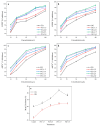Quantitative Analysis of Ginger Maturity and Pulsed Electric Field Thresholds: Effects on Microstructure and Juice's Nutritional Profile
- PMID: 40807574
- PMCID: PMC12346581
- DOI: 10.3390/foods14152637
Quantitative Analysis of Ginger Maturity and Pulsed Electric Field Thresholds: Effects on Microstructure and Juice's Nutritional Profile
Abstract
This study used fresh (young) and old (mature) ginger tissues as model systems to investigate how plant maturity modulates the response to pulsed electric field (PEF), a non-thermal processing technology. Specifically, the influence of tissue maturity on dielectric behavior and its downstream effect on juice yield and bioactive compound extraction was systematically evaluated. At 2.5 kV/cm, old ginger exhibited a pronounced dielectric breakdown effect due to enhanced electrolyte content and cell wall lignification, resulting in a higher degree of cell disintegration (0.65) compared with fresh ginger (0.44). This translated into a significantly improved juice yield of 90.85% for old ginger, surpassing the 84.16% limit observed in fresh ginger. HPLC analysis revealed that the extraction efficiency of 6-gingerol and 6-shogaol increased from 1739.16 to 2233.60 µg/g and 310.31 to 339.63 µg/g, respectively, in old ginger after PEF treatment, while fresh ginger showed increases from 1257.88 to 1824.05 µg/g and 166.43 to 213.52 µg/g, respectively. Total phenolic content (TPC) and total flavonoid content (TFC) also increased in both tissues, with OG-2.5 reaching 789.57 µg GAE/mL and 336.49 µg RE/mL, compared with 738.19 µg GAE/mL and 329.62 µg RE/mL in FG-2.5. Antioxidant capacity, as measured by ABTS•+ and DPPH• inhibition, improved more markedly in OG-2.5 (37.8% and 18.7%, respectively) than in FG-2.5. Moreover, volatile compound concentrations increased by 177.9% in OG-2.5 and 137.0% in FG-2.5 compared with their respective controls, indicating differential aroma intensification and compound transformation. Structural characterization by SEM and FT-IR further corroborated enhanced cellular disruption and biochemical release in mature tissue. Collectively, these results reveal a maturity-dependent mechanism of electro-permeabilization in plant tissues, offering new insights into optimizing non-thermal processing for functional food production.
Keywords: cell disintegration; ginger maturity; juice yield; nutritional profile; pulsed electric field.
Conflict of interest statement
The authors declare no conflicts of interest.
Figures







Similar articles
-
Prescription of Controlled Substances: Benefits and Risks.2025 Jul 6. In: StatPearls [Internet]. Treasure Island (FL): StatPearls Publishing; 2025 Jan–. 2025 Jul 6. In: StatPearls [Internet]. Treasure Island (FL): StatPearls Publishing; 2025 Jan–. PMID: 30726003 Free Books & Documents.
-
Effect of Thermal Processing by Spray Drying on Key Ginger Compounds.Metabolites. 2025 May 24;15(6):350. doi: 10.3390/metabo15060350. Metabolites. 2025. PMID: 40559374 Free PMC article.
-
Phytochemical composition and bioactivity of Debregeasia saeneb leaves: Insights into anti-diabetic and antioxidant properties.PLoS One. 2025 Jul 2;20(7):e0326991. doi: 10.1371/journal.pone.0326991. eCollection 2025. PLoS One. 2025. PMID: 40601679 Free PMC article.
-
Systemic pharmacological treatments for chronic plaque psoriasis: a network meta-analysis.Cochrane Database Syst Rev. 2021 Apr 19;4(4):CD011535. doi: 10.1002/14651858.CD011535.pub4. Cochrane Database Syst Rev. 2021. Update in: Cochrane Database Syst Rev. 2022 May 23;5:CD011535. doi: 10.1002/14651858.CD011535.pub5. PMID: 33871055 Free PMC article. Updated.
-
Systemic pharmacological treatments for chronic plaque psoriasis: a network meta-analysis.Cochrane Database Syst Rev. 2017 Dec 22;12(12):CD011535. doi: 10.1002/14651858.CD011535.pub2. Cochrane Database Syst Rev. 2017. Update in: Cochrane Database Syst Rev. 2020 Jan 9;1:CD011535. doi: 10.1002/14651858.CD011535.pub3. PMID: 29271481 Free PMC article. Updated.
References
-
- Laelago Ersedo T., Teka T.A., Fikreyesus Forsido S., Dessalegn E., Adebo J.A., Tamiru M., Astatkie T. Food flavor enhancement, preservation, and bio-functionality of ginger (Zingiber officinale): A review. Int. J. Food Prop. 2023;26:928–951. doi: 10.1080/10942912.2023.2194576. - DOI
-
- Sharma S., Shukla M.K., Sharma K.C., Tirath, Kumar L., Anal J.M.H., Upadhyay S.K., Bhattacharyya S., Kumar D. Revisiting the therapeutic potential of gingerols against different pharmacological activities. Naunyn-Schmiedeberg’s Arch. Pharmacol. 2023;396:633–647. doi: 10.1007/s00210-022-02372-7. - DOI - PMC - PubMed
Grants and funding
LinkOut - more resources
Full Text Sources
Miscellaneous

